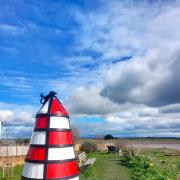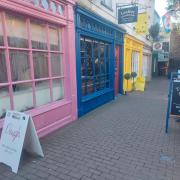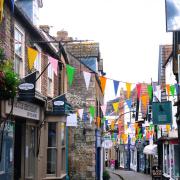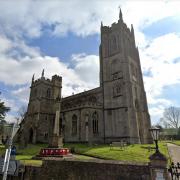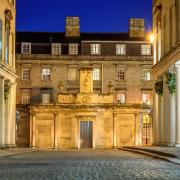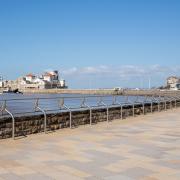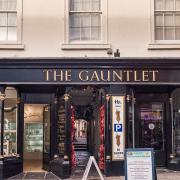Malcolm Rigby encounters stories of heroes and bishops, brothels and palaces, on his walk around Wells, an iconic Somerset city. Photos by Neville Stanikk.
Malcolm Rigby encounters stories of heroes and bishops, brothels and palaces, on his walk around Wells, an iconic Somerset city. Photos by Neville Stanikk.
The eyes of the world turned briefly to Wells a couple of months ago for the memorial service of Harry Patch, Britain's last remaining soldier from the First World War, who died at the age of 111. Locals and dignitaries, including the Duchess of Cornwall, packed the cathedral for the ceremony and thousands more lined the pavements of the city to pay their respects before moving on to the Cathedral Green to view the service on the big screen. The last tommy, recently dubbed Mr Somerset, had for some time been a familiar and popular face on the streets of Wells.Everyone knows that Wells is the smallest city in England but not everyone knows that for two years between 1972-74 it wasn't technically a city at all: local government reorganisation caused this and a new royal charter put it all to rights, so William Smith, City Archivist, tells me as he leads me from the town hall into the market place. The cathedral may have the splendour and the Bishop's Palace the tranquillity, but the market place is the fulcrum of the city. It is busy any day of the week with tourists and shoppers, particularly so on market days, Wednesday and Saturday. In the middle of the square there used to be a market hall called the Exchequer; it was here that Judge Jeffreys condemned 543 rebels - 99 to be hanged and the rest to be transported. The Town Hall itself was built in 1778, the right side used to be the police station and William tells me that on a bright day you can just make out the lettering.On the pavement in front of the shops at the market place is a commemorative brass tribute to Mary Rand, who was born and grew up in the city. The design marks the distance she jumped when she created the world record in the women's long jump at the Tokyo Olympic Games in 1964. Passing through Penniless Porch, so-called because for centuries it has been a favourite spot for beggars, although now you have to have a licence to busk, you emerge on the Cathedral Green and the wonderful west front stands before you. Such an icon is the cathedral that after the filming of the hit movie Hot Fuzz (directed by Wells man Edgar Wright) in the city, the building had to be airbrushed out of all the shots so that the location could be restored to anonymity. Wider than it is high, the west faade boasts more than 300 statues - carvings which during the Middle Ages were painted in bright colours. The first English Gothic cathedral, it was started in 1180 and completed in 1239; thanks to its non-monastic status it survived the dissolution, unlike the abbey down the road at Glastonbury. Inside there is much to admire, perhaps most notably the medieval clock with jousting knights that appear every quarter of an hour, the famous scissor arches that stop the tower sinking into the soft soil beneath and the 14th-century stone steps to the Chapter House worn down by the tread of millions of steps.Crossing the green you find the Chain Gate. Built by Bishop Beckynton, as was much of the surrounding architecture, it provided a covered passageway for the Vicars Choral to get from their hall to the cathedral. Adjacent to this is the Vicars Close, said to be the oldest complete, continuously inhabited medieval street in Europe. The story goes that the housing was built for the bachelor choristers so that they would not be tempted by the alehouses and young ladies who might make them late for their duties. Curiously the road is tapered so as to give the optical illusion that it is longer than it is.Close by also on the green there is the Wells and Mendip Museum housed in the old chancellor's building. Focusing on the history of the town and the geology of the area, there are Stone Age tools, Iron Age artefacts, the skull of a brown bear found at Wookey Hole and a collection of samplers from the 18th century.Returning to the market place and this time proceeding through the gatehouse known as the Bishop's Eye, I find myself in front of the peaceful and restful Bishop's Palace, described by architectural historian Pevsner as 'the most memorable of all Bishop's Palaces in England'. Bishops have been living here for 800 years although the present incumbent has just a small private residence in the north wing. Guarded by a moat and fortifications, apart from the odd Parliamentarian canon ball the building has seen little military action and the most tragic event happened in the great storm of 1703 when Bishop Kidder and his wife were killed in their bed when a chimney came crashing through the roof. Inside the main building is the Henderson Room, which contains a gallery of portraits of former bishops, whilst down below in the cooling Undercroft is a caf�. The great hall, built for a royal visit that never took place, is now just two walls of romantic ruins that create a wonderful atmosphere. The gardens outside the moat are home to the springs that give Wells its name and the swans on the water are meant to ring a bell for food when they are hungry. It is truly a magical place.Heading south this time from the market place on High Street, first-time visitors will be surprised by the gutters of fresh Mendip spring water that flows alongside the road - the water was a gift to citizens from Bishop Bekynton. Number 8 used to be an inn called Prince Charles' Parlour and apparently there is a ghost dressed as a cavalier that descends the Jacobean staircase. There are some familiar names like Starbucks and Waterstones, but also some independents, including a good handful of gift shops and a splattering of charitable enterprises.Halfway down the main drag on the right is Union Street, currently home to the public library. Apparently the road used to be known as Grope Lane because it housed most of the brothels of the city before the prudish Victorians renamed it Grove Lane.Veering off down Cuthbert Street you reach the Parish Church of St Cuthbert's. This is the largest in Somerset and also has the third highest tower in the county so it is perhaps not surprising that more than one American tourist has believed it to be Wells Cathedral. Built in the 1200s, inside is an interesting painted timber ceiling that was added a couple of centuries later.William tells me: "What I like about Wells is that it is still a very unhurried and peaceful place. What I don't like about it is that it has suffered heavily, like many towns in England, from the motor car." That said, no doubt it would be a great deal worse without the opening of the relief road in 1997.Former Freemen of this small but charming city include William Pitt the Elder, but returning to the town hall and its noticeboards I discover that the last person to be made a Freeman was one Harry Patch.





